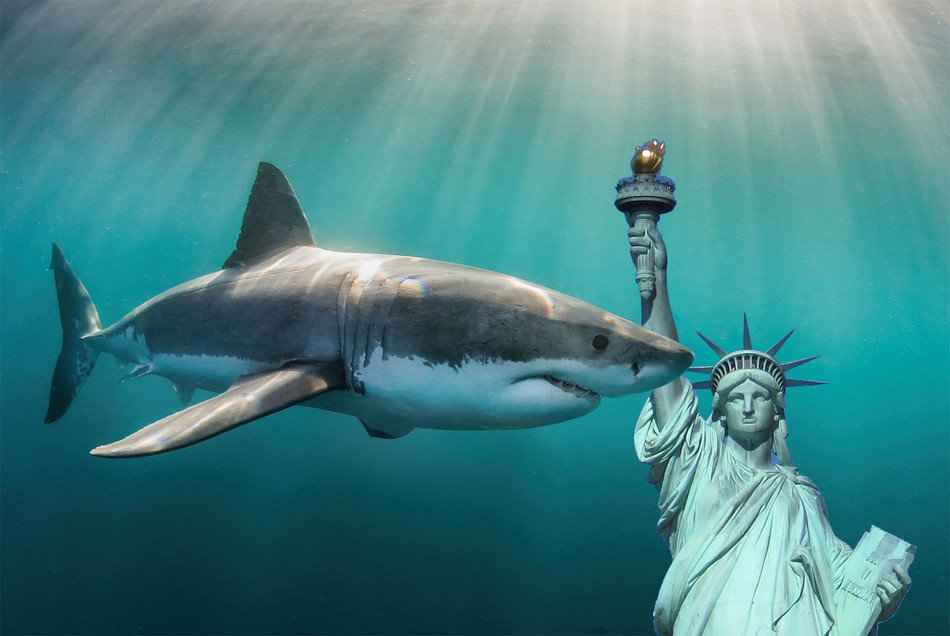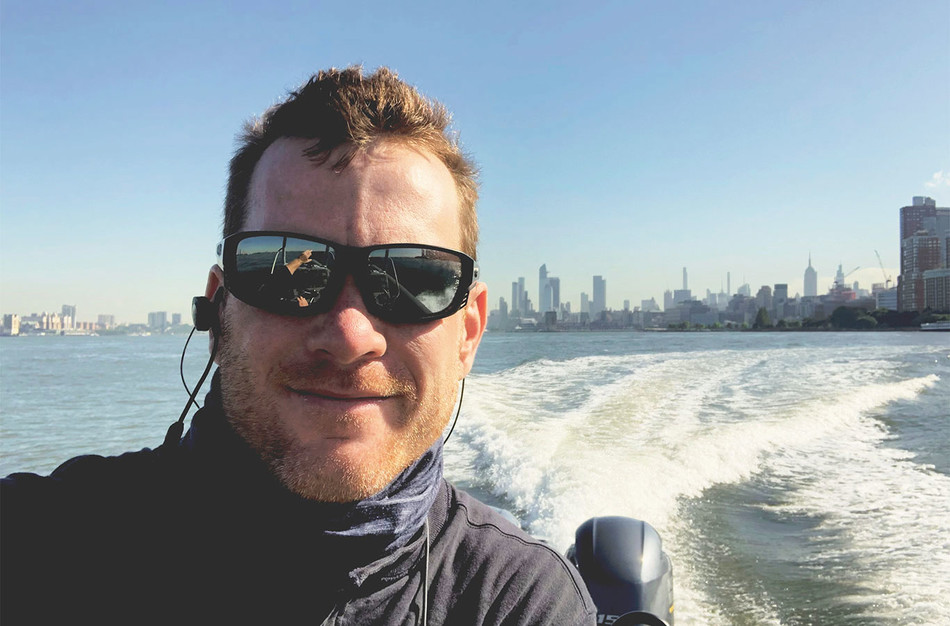On a hot Saturday in July, Patrick Nason ’18GSAS, dressed in black cycling shorts, a dark-gray T-shirt, wraparound sunglasses, and a baseball cap the pink of a shark’s gums, welcomes a family of eight and a young couple onto the dock at North Cove Marina in Lower Manhattan. “Hi, I’m Captain Pat,” he says, radiating affability as he helps the passengers clamber aboard the small, twenty-nine-foot vessel. Nason takes his place at the wheel, and steers the New York Media Boat into the smoke-green waters of the Hudson for a short sightseeing cruise. With two kids on board, he’s more than ready for the inevitable question: Are there sharks?
Yes, there are sharks. In the waters around New York City, with its 520 miles of coastline, there are, in addition to resurgent dolphins, whales, and seals, some two dozen species of sharks: sand sharks, blue sharks, white sharks, brown sharks. There are makos, the fastest sharks in the world. There are hammerhead sharks, and blacktip reef sharks from the Caribbean. There are basking sharks, thirty-foot monsters, the world’s second-largest fish after the whale shark. And while you’re not likely to spot a telltale dorsal fin during a speedy tour around the tip of Manhattan to the Brooklyn Bridge and back, Nason is keenly aware of what swims beneath.
An anthropologist, diver, marine conservationist, and boat captain, Nason, thirty-eight, has spent most of his adult life thinking about the torpedo-shaped predator that has scavenged the seas for 450 million years. He has peered into the fathomless black eye of the shark and found terrible and beautiful inklings about what it means to be human. And he has studied the role of the shark in human culture, working with fishing communities, ecologists, and oceanographers to understand how oceanic spaces are imagined, explored, and controlled. “I’m out on the river every day, and I see the comeback of these sharks,” he says, noting the record number of shark sightings along Long Island’s South Shore beaches. He points toward the Verrazano Narrows Bridge in the distance. “Just past the bridge there’s a safe spot where the great whites have their pups.”
Nason refutes the prevailing cultural trope of the shark as bloodthirsty maneater, an image pumped up each summer with the inevitable handful of biting incidents involving people. “Sharks don’t hunt humans,” he says. “They have a sensory system that draws them toward any sort of electrical currents or any pressure changes in the water, and sometimes they mistake a human for their natural prey, such as seals and whales.”
And it’s the seals and whales, says Nason, that help explain the shark spike. Climate change, too, is a factor — warming waters have brought some species farther north — but it’s the decades-long cleanup of the river, which had been heavily polluted with PCBs through the 1970s, that has restored the food chain: an increase of Atlantic menhaden, a type of herring, has brought herring-munching whales; and the sharks, also herring eaters, track the whales, who are nice and meaty themselves.
“The hunch is that the sharks follow the humpback whales,” Nason says. “So many whales have come back to the harbor, and once in a while a whale will get struck by a ship. The shark’s system is attuned to blood and vibrations, so they’ll swim right in and eat an injured or dying animal, cleaning things up and strengthening the whole food chain.”
Nason’s fascination with sharks began in 2005 in Papua, New Guinea, where he worked at a tourist resort as a diver. One day while diving on a reef ten miles offshore he came face to face (if that’s possible with a creature whose eyes are located at either end of a long, flat, mallet-shaped head) with a great hammerhead shark. There were three sharks: a male and two females. “They really checked us out,” Nason says. “They swam right up to us, looked at us. Huge hammerheads. Twelve feet long. Big sharks. They just — humbled us.” The humans stared back and let the sharks investigate them. There was nothing else to do. Then the fish swam off. “Back on the boat we were all in awe, speechless, just amazed at what had happened.”
Four years later, while getting his master’s in anthropology at Florida Atlantic University (his thesis was on conflicts between resource extractors, resource users, and conservationists), Nason was working as a captain on scuba-diving boats in South Florida. That’s when he saw another great hammerhead. But this shark was hanging from the rigging of a sport-fishing boat. The sight of the conquered creature touched a nerve in Nason. He started doing ethnographic work on the history of local shark-hunting tournaments, interviewing conservationists, scientists, and shark fishermen. Then he used his master’s thesis to get into a PhD program in cultural anthropology at Columbia.
On Morningside Heights, Nason continued his work, exploring the successes and failures of conservation efforts. “With all the amazing resources at Columbia, I took classes in critical theory, including literature on human-animal interaction,” Nason says. “Columbia’s just so wonderful for that mix of science and humanities.” Nason’s academic papers, dripping with references to Lacan, Derrida, and Nietzsche, are filled to the gills with ruminations on the shark in the human imagination and the need to subdue and dominate a perceived enemy.
Nason had always wanted to return to the scene of his first shark encounter, and so he decided to focus his dissertation on the tradition of shark-calling in Papua New Guinea. According to custom, the indigenous fishermen lure sharks to their canoes by reproducing, vocally, the sound of a school of tuna thrashing on the surface of the water. Once the sharks approach, the men capture them and, in displays of brute strength, haul them out of the water.
“It’s this moment where they articulate their sea tenure, their standing, and their claim to that marine space,” Nason says. Ethnographically, he wanted to know: What does the shark mean to them? What does it mean to kill a shark, or any animal? What are the economics of it, the cultural connections, the spiritual practices?
Nason is completing a book about his research. He also lectures at Barnard and lends his expertise to the Shark Research Institute in Princeton, New Jersey, a nonprofit dedicated to shark conservation. In the last fifty years, according to the journal Nature, the world shark population has decreased by 70 percent. More than a hundred million are killed each year, mainly for their fins, a key ingredient in the Asian delicacy shark fin soup.
As an advocate for shark protection, Nason struggles against an overwhelming tide. Still, for him, the glass — or rather, the harbor — is half full. As he skippers the boat back to the marina, he gestures again to the Verrazano Narrows Bridge. It’s worth repeating, and Nason does, that beyond those towers and cables, out in the New York Bight, there lies a shark nursery for sand tigers, makos, and great whites. It’s a feature of the city unknown to most people out on the water this summer day, but for Captain Pat’s guests it’s a fact as big as any bridge or statue, and a reminder that not all the sharks of New York wear suits.
“Sharks make us look back at ourselves,” Nason says. “They reflect the history and development on the coast, recreational and fishing practices, and economics. They make us aware of our own place on the planet. Any time sharks make an appearance, they force us to ask questions.”




